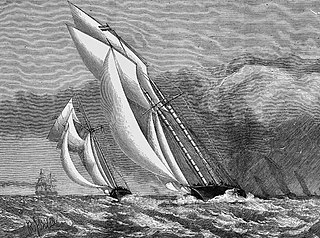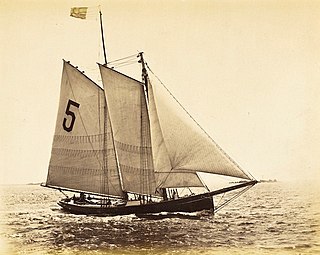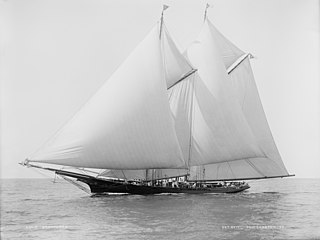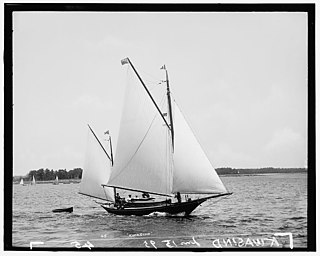
The New York Yacht Club (NYYC) is a private social club and yacht club based in New York City and Newport, Rhode Island. It was founded in 1844 by nine prominent sportsmen. The members have contributed to the sport of yachting and yacht design. As of 2001, the organization was reported to have about 3,000 members. Membership in the club is by invitation only. Its officers include a commodore, vice-commodore, rear-commodore, secretary and treasurer.

America was a 19th-century racing yacht and first winner of the America's Cup international sailing trophy.
The 2005 Rolex Transatlantic Challenge was celebrated at the 100th anniversary of the 1905 race for the Kaiser's Cup also known as "The Great Ocean Race". In this race, there was a skipper named Charlie Barr who raced the 3-masted schooner called Atlantic across the ocean for nearly 3,000 nautical miles (6,000 km) of the North Atlantic to set a monohull unbeaten record for the 1905 course of exactly only 12 days, 4 hours, 1 minute and 19 seconds.

The Atlantic was built in 1903 by Townsend and Downey shipyard, and designed by William Gardner, and Frederick Maxfield Hoyt for Wilson Marshall. The three-masted schooner was skippered by Charlie Barr who was accompanied by navigator and tactician Frederick Maxfield Hoyt when it set the record for fastest transatlantic passage by a monohull in the 1905 Kaiser's Cup race. The record remained unbroken for nearly 100 years.

George Lawley & Son was a shipbuilding firm operating in Massachusetts from 1866 to 1945. It began in Scituate, then moved to Boston. After founder George Lawley (1823–1915) retired in 1890, his son, grandson and great-grandson upheld the business, which continued until 1945. Of the hundreds of ships built by the Lawleys, highlights include the yachts Puritan and Mayflower, respective winners of the 1885 and 1886 America's Cup.
Kaiser's Cup was a yachting race across the Atlantic between Sandy Hook, New Jersey (USA) and The Lizard. This was a famous sailing race of the day, and was won by the yacht Atlantic which held the record for nearly a century

Robert "Bob" Fish was known as the oldest and most successful of the 19th-century American yacht modelers and shipbuilders. He was well known for remodeling of the Sappho that won 3 successive international races.

The Enchantress was a 19th-century racing yacht, winner of several national and international Cups including the Royal Yacht Squadron's 53-mile (85 km) regatta around the Le Havre to Southampton, and the New York Yacht Club's 140-mile (230 km) regatta from Owl's Head Point to Sandy Hook Lightship. She was designed by Robert Fish for George L. Lorillard.

The Moses H. Grinnell was a 19th-century pilot boat built in 1850 for the New York maritime pilots. She was designed by the yacht designer George Steers. The Grinnell was the first pilot boat to feature a fully developed concave clipper-bow, which was to become the New York schooner-rigged pilot boat's trade mark. This new design was the basis for the celebrated yacht America.

The Sylph was a 19th-century pilot boat first built in 1834, by Whitmore & Holbrook for John Perkins Cushing as a Boston yacht and pilot-boat for merchant and ship owner Robert Bennet Forbes. She won the first recorded American yacht race in 1835. She was a pilot boat in the Boston Harbor in 1836 and 1837 and sold to the New York and Sandy Hook Pilots in October 1837. She was lost in winter of 1857 with all hands during a blizzard off Barnegat, New Jersey. The second Sylph was built in 1865 from a half-model by Dennison J. Lawlor. The third Sylph was built in 1878 at North Weymouth, Massachusetts for Boston Pilots. She was sold out of service in 1901, after 23 years of Boston pilot service.

The Hesper was a 19th-century Boston pilot boat built in 1884, designed from a model by Dennison J. Lawlor as a Boston yacht and pilot-boat for merchant and ship owner George W. Lawler. She was known to be the largest pilot boat under the American flag at 104 feet long and the fastest of the Boston fleet. She competed in several first-class sailing races, and in 1886, the Hesper won the silver cup in what was known as the first Fishermen's Race. She was withdrawn from the pilot service and sold in 1901. The Hesper became a wreck on the point off Cape Henlopen in 1919.

The Mary Taylor was a 19th-century yacht and Sandy Hook pilot boat, built at the Hathorne & Steers shipyard in 1849 for Captain Richard Brown. She was designed by George Steers with a new radical design with a long thin bow and wide stern, which made her faster than any other boat in her class. This design proved successful and led to the famous yacht America, which won the America's Cup in 1851. The Mary Taylor sank after colliding with the schooner Fairhaven in 1863. She was replaced by the Mary E. Fish.

The Widgeon was a 19th-century yacht and Sandy Hook pilot boat, built in 1855 by James R. & George Steers for Daniel Edgar of the New York Yacht Club and designed by George Steers. She came in 17th in an unsuccessful America’s Cup defense in 1870. Widgeon was sold in 1871 to a group of New York pilots to replace the John D. Jones, which sank in a collision with the steamer City of Washington. New York pilots condemned the Widgeon as unseaworthy in 1879, which sparked a fight for steam pilot-boat service. In 1883 a decision was affirmed by the Supreme Court and the Board of Commissioners of Pilots that pilot boats could be "propelled" by steam.

The Mary E. Fish was a 19th-century Sandy Hook pilot boat, built at the Edward F. Williams shipyard of Greenpoint, Brooklyn in 1861 for Richard Brown and the New York Pilots. She was built to replace the Mary Taylor. The Fish was hit and sank by the schooner Frank Harrington in 1885 and replaced by the David Carll.

The Gracie was a 19th-century racing sloop yacht built in 1868 by James E. Smith shipyard at Nyack, New York. She raced the America's Cup defender Mischief in the trails off Sandy Hook in 1881. Gracie raced at the New York Yacht Club, Atlantic Yacht Club and other eastern yacht clubs. After a 42 year career in racing, she was sold in 1909 and converted to a freight boat sailing from Milton Point, off Long Island to New York.

Franklin Osgood was a 19th-century businessman and yachtsman. He was one of the most experienced yachtsman having sailed for more than 23 years. He was owner and manager of the racing yachts Widgeon, Columbia, and Magic. He was the first defender and two-time winner of the America's Cup. Osgood was inducted into the America's Cup Hall of Fame in 2020.

The Dauntless was a 19th-century wooden yacht schooner, designed and built in 1866 by Forsyth & Morgan at Mystic Bridge, Connecticut, and owned and sailed by noted yachtsmen, among them James Gordon Bennett Jr. and Caldwell Hart Colt. She was first called the L'Hirondelle and later renamed the Dauntless. The Dauntless was in three Trans-Atlantic matches for the New York Yacht Club. She came in fourth in an unsuccessful America’s Cup defense in 1870.

The Phantom was a 19th-century centerboard schooner-yacht built in 1865 by Joseph D. Van Deusen and first owned by yachtsman Henry G. Stebbins. She was one of the fastest yachts in the New York squadron. The Phantom won 1st place in the June 1867 New York Yacht Club regatta. She came in 7th place in an unsuccessful America's Cup defense in 1870. She was sold as a racing yacht several times before she went out of service in 1900.

The Idler was a 19th-century schooner-yacht built in 1864 by Samuel Hartt Pook from Fairhaven, Connecticut and owned by yachtsman Thomas C. Durant. She was one of the fastest yachts in the New York squadron. Idler came in 2nd place in the America’s Cup defense in 1870. She was sold as a racing yacht several times before she capsized and sank in 1900.

Elbridge T. Gerry was a 19th-century New York Sandy Hook pilot boat built in 1888 at the Robinson & Waterhouse shipyard in City Island, Bronx. She was named in honor of Elbridge Thomas Gerry, a commodore of the New York Yacht Club. She served as a pilot boat from 1888 to 1896, when she was sold for offshore yachting cruises. Her name was changed to Kwasind, after the strongman in Henry Wadsworth Longfellow's Song of Hiawatha.


















